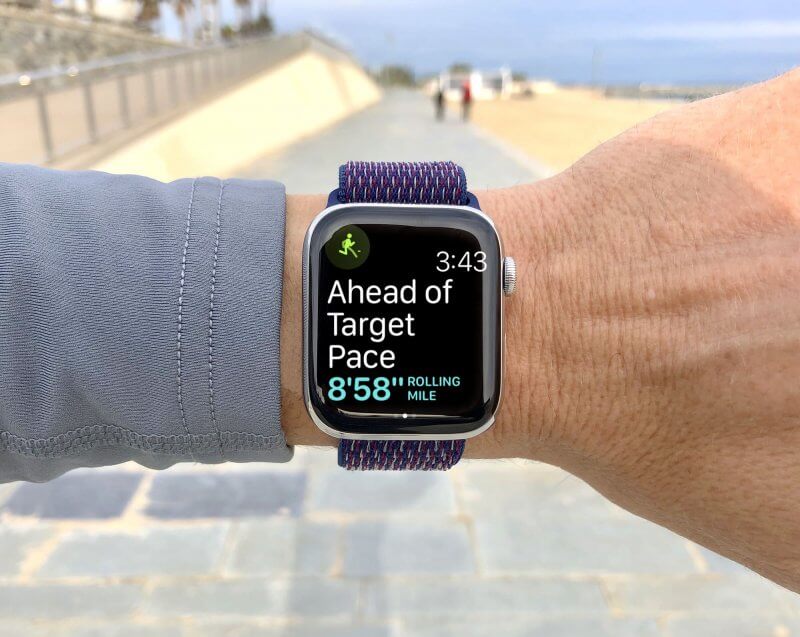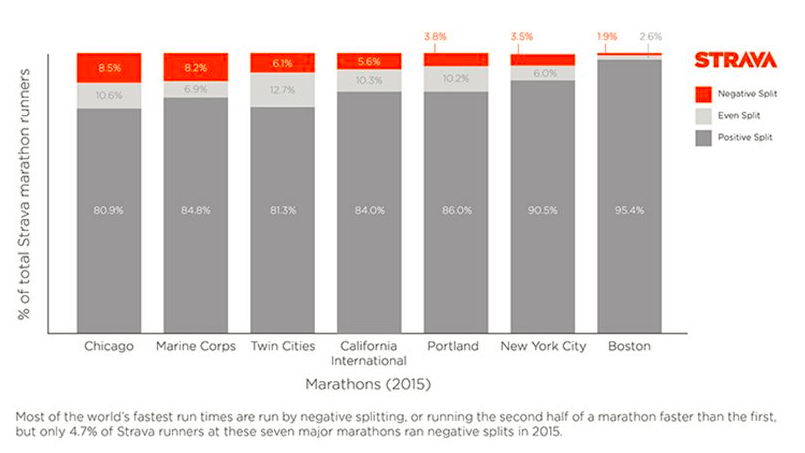Should You Run Negative Splits?

There are many terms thrown around in the running world that newbie runners may not understand (negative splits?). When you just start out running, it can be hard to navigate through all of it. If you are new to racing, you probably just take off with the intention of running as fast as you can for as long as you can. It makes sense, doesn’t it?
When you first start training for a race, let’s say a 5K, you might find yourself starting out fast, then slowing down some in your second mile, and the third mile might be the slowest yet. Did you know that is not the best practice when racing?
Most coaches will encourage you to negative split. This article will delve into what a negative split is and why you want them.
What Is A Negative Split?
When running a negative split, you are running the back half of a race faster than the first half. This is because in a shorter distance race (does that sound like an oxymoron?), you are getting progressively faster with each mile. In longer distance races, such as a half-marathon, you may divide the race clearly in half and just focus on going ever so slightly faster.
Are Negative Splits Good?
Most coaches agree that the concept of negative splits is good. Why? Because you are forced to run smart. To run a negative split race, you need to know what pace you can hold for the duration of the race distance.
You need to run smart and disciplined because you have to maintain a steady pace throughout the entire first one-half of the race. You cannot let adrenaline allow you to run faster than you should. You cannot get caught up in the pace of those surrounding you along the route.

If you accidentally go out too fast in a race, you will likely expend more energy in the first part of the race, which can cause you to struggle later on. In a shorter race, like a 5K, you can typically hang on. However, starting too fast can be dangerous in a half or full marathon.
Using this logic, negative splits are not only good, but they also help you run smarter and stronger!
Tips For Running Negative Splits
If you are racing, one thing you can do to run negative splits is to join a pace group. Pacers tend to have the skills to hone in at an exact pace for a long period of time. Once you get to the halfway point of your race, you can pick up the pace a bit, increasing your pace.
Runners with smartwatch technology such as the Garmin may have a setting that helps them to hone in on a particular pace. You can set the watch to “hum” at a certain pace. This keeps you from running too fast. Since you can’t switch the pace on the fly, this is useful for training but not for race circumstances. However, if you have specific pace goals, you need to learn what a particular pace feels like.
You won’t find it easy to run negative splits in a race environment unless you practice it. Start with shorter distances. Focus on running each mile slightly faster than the one before. Once you have mastered the feel of this, think about trying a longer distance.
An example would be taking a 5-mile training run, staying at a consistent pace for the first three miles, and then kicking it in a notch faster for the next two.
How Do You Run A Negative Split In A 5K?
If you are attempting to run a 5K using negative splits, you will likely divide the race into three distinct portions. You should go out at a challenging pace in the first mile of the race, but not one that would leave you unable to hold that pace for 3 miles. For example, if I were trying to run a sub 25:00 minute 5K, I would likely try to run right around 8:00 minute mile for mile 1.
For the second 1/3 of the race, you should check your time and pace at the first mile and ratchet it down just a touch. Don’t think about hitting the hammer down yet; you are just trying to speed up a touch. Keep yourself relaxed and moving forward. Go faster but not wicked fast.
In the final mile (or last 1/3) of the race, you are putting the hammer down. This is where you dig deep and run with your heart. When you focus and get your wheels turning, after conserving energy in the first half, you should be able to negative split.
What about the final .1 of the 3.1? That’s just a short glimpse of blood, sweat, and tears. Get to work and finish with everything you have. That portion should definitely be faster than the other three parts!
Should You Negative Split In A Marathon?
Negative splitting a marathon is much more difficult for many reasons. First, most people only run a marathon a year (maybe two). This makes the marathon a difficult beast to conquer.

Also, when you are on a course for 26.2 miles, many things can happen. Getting negative splits while running is difficult at any distance. Figuring it out over a longer run is even more so. When you are looking at negative splits for a marathon, most people break that into two pieces and just focus on each half marathon.
For us mere mortals, the main focus is just running the second half of the race slightly faster than the first. Sound easy? It is not.
What Is A Positive Split Run?
A positive split run just means you are taking more time to run the second half of the race slower than the first half. Did you know that many world-record marathon efforts have been positive split runs? Yup. In other words, it does not have to be treated like a kiss of death in the racing world.
If you are new to running, try not to overthink it. If it is your first marathon, you should not worry too much about negative or positive splits. Just get out there and run your best. Try to stay consistent and hope that external forces such as weather don’t throw you off of your game.
Trying The Negative Split
If you have been running a while and have a goal race in mind, it certainly is worth your effort to try negative split efforts. To accomplish this, you might want to do negative split workouts. For example, run 800-meter repeats that get faster with each effort. Workouts like this help to prepare you for a negative split race.

Another workout is just to focus on running each mile faster after effectively warming up your body. Remember that if you intentionally start out super slow then start to speed up, that does not really count.
Whatever you plan to try to increase your speed and improve your running game, don’t forget to run happy, friends! Mindset is important.
Latest Articles
 Is Running on a Treadmill Easier Than Running Outside?Runners have their own preferences, whether it is treadmill running, running outside on the road, or exploring trails. So...
Is Running on a Treadmill Easier Than Running Outside?Runners have their own preferences, whether it is treadmill running, running outside on the road, or exploring trails. So... Is It OK to Use Trail Running Shoes on the Road?While trail running shoes can be used on roads, especially in situations where a runner encounters mixed terrains or pref...
Is It OK to Use Trail Running Shoes on the Road?While trail running shoes can be used on roads, especially in situations where a runner encounters mixed terrains or pref... How to Fix Sore Quads After Running?Rest, ice, gentle stretching, and over-the-counter pain relievers can help soothe sore quads after running. Also, ensure ...
How to Fix Sore Quads After Running?Rest, ice, gentle stretching, and over-the-counter pain relievers can help soothe sore quads after running. Also, ensure ... 10 Fruits With The Most Electrolytes to Replace Sports DrinksThese fruits are high in electrolytes such as potassium, magnesium, and calcium, essential for hydration, muscle function...
10 Fruits With The Most Electrolytes to Replace Sports DrinksThese fruits are high in electrolytes such as potassium, magnesium, and calcium, essential for hydration, muscle function...

